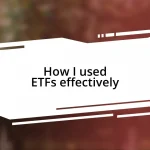Key takeaways:
- Understanding investment costs, including hidden fees like trading commissions and expense ratios, is crucial for maximizing returns.
- Diversifying across various asset classes (stocks, bonds, real estate, etc.) can reduce risk and enhance potential returns.
- Utilizing low-cost index funds and tax-efficient investing strategies can lead to significant savings and improved financial outcomes.
- Regularly reviewing and adjusting your portfolio helps align investments with evolving financial goals and market conditions.

Understanding investment costs
Investment costs can sometimes feel overwhelming, especially when you’re just starting out. I remember my first attempt at investing; I was blindsided by multiple fees—transaction fees, management fees, and others that seemed to appear out of nowhere. Have you ever felt like your hard-earned money was slipping away because of hidden costs?
Understanding the various types of investment costs is crucial to making informed decisions. For instance, I’ve learned over time that not all fees are created equal; some are justified by the services provided, while others can seem excessive. It’s like shopping for a car—you don’t want to pay for features you don’t need, right?
One of the key aspects to grasp is the difference between upfront and ongoing costs. When I invested in my first mutual fund, I focused solely on the initial buy-in. However, it was the annual fees that continually ate away at my returns—definitely a lesson learned! What about you? Do you keep track of your ongoing costs, or do they sneak up on you like they did with me?

Identifying hidden fees
Identifying hidden fees can feel like detective work. I recall pouring over my investment statements—updating my budget as I noticed those unexpected charges inching their way in. It’s frustrating to find out later that fees I overlooked were nibbling away at my profits. It taught me the importance of digging deeper and questioning everything.
Here’s a list of common hidden fees to watch out for:
- Trading Commissions: Charges for buying or selling investments.
- Expense Ratios: Annual fees for managing mutual funds or ETFs that can significantly impact returns over time.
- Account Maintenance Fees: Monthly or annual charges just for having an account open.
- Load Fees: Charges that apply when you buy into mutual funds, either at the front end (front-load) or back end (back-load).
- Advisory Fees: Ongoing costs for financial advisors, which can sometimes be a percentage of your total assets.
Being aware of these costs enables you to ask better questions and ultimately safeguard your investment returns.

Diversifying investment options
When I decided to diversify my investment options, it felt like embarking on an exciting journey. I realized that spreading my investments across different asset classes, like stocks, bonds, and real estate, would not only reduce risk but also improve my potential for returns. Have you ever thought about how a diversified portfolio acts like a safety net? It helps cushion against market fluctuations, allowing for greater peace of mind.
For example, when I first allocated a portion of my investments into real estate, I was amazed at how it transformed my overall financial picture. While stocks might rise and fall with the economy, property values tend to appreciate over time, bringing stability into my portfolio. This blend of assets kept me from feeling too anxious during market downturns, which I’ve found can be a game-changer for both mental and financial health.
I often encourage friends to explore alternative investments, such as index funds or peer-to-peer lending, which have been lucrative for me. Though it can be intimidating at first, each new venture provides valuable experience that refines your investment strategy. By diversifying, you create multiple streams of revenue—something I believe everyone should strive for in their financial journey.
| Investment Option | Potential Risks |
|---|---|
| Stocks | High volatility; market fluctuations |
| Bonds | Lower returns; interest rate sensitivity |
| Real Estate | Illiquidity; market downturns |
| Index Funds | Market risk; less control over individual asset choices |
| Peer-to-Peer Lending | Default risk; less regulation |

Using low-cost index funds
Using low-cost index funds has been one of my most impactful financial decisions. I recall the first time I dipped my toes into index investing; it was exhilarating! The simplicity of these funds appealed to me. Instead of worrying about picking individual stocks, I could invest in a broad market index and simply watch my investment grow over time.
I’ve found that low-cost index funds often have significantly lower expense ratios than actively managed funds, allowing me to keep more of my returns. It’s fascinating to consider how just a small percentage saved on fees can lead to substantial growth in the long run. For instance, I did the math and realized that by investing in an index fund with a 0.05% expense ratio instead of a 1% fund, I could save thousands over decades—money that could instead be working for me. Have you ever thought about how those small savings can build up?
Using index funds has also brought a sense of peace to my investing journey. Knowing that I’m investing in a diverse range of companies rather than trying to predict which ones will outperform has made my approach less stressful. The performance of the fund reflects the market as a whole, which I’ve found to be a much less daunting task than trying to navigate the ups and downs of individual stocks. It feels liberating to invest with a strategy based on proven principles rather than day-to-day market whims.

Practicing tax-efficient investing
Practicing tax-efficient investing has been a game-changer for me. Initially, I underestimated the impact taxes could have on my returns. When I started to focus on tax efficiency, I began to implement strategies like holding investments long-term to benefit from lower capital gains taxes. Honestly, it’s shocking how much of a difference a few extra percentage points in tax savings can make over time. Have you ever considered how your choice of investment accounts can alter your tax bill?
I also pay close attention to my asset location. By placing tax-inefficient investments in tax-advantaged accounts, like retirement accounts, I’ve managed to keep more of my hard-earned money working for me. For instance, I discovered that by holding my bonds in an IRA instead of a taxable account, I could significantly minimize the tax drag on my overall returns. Have you thought about how strategic placement can revolutionize your investment outcomes?
Moreover, tax-loss harvesting has been a nifty strategy I’ve embraced. It’s incredible how selling losing investments to offset gains can lead to a more favorable tax situation. Once, I sold a few stocks that weren’t performing well, and the losses helped reduce my capital gains from other sales. It felt empowering to take a proactive approach to my taxes. Have you explored the idea of actively managing your tax situation? Trust me, being mindful of how taxes influence your investment decisions can be both enlightening and rewarding.

Leveraging investment apps
Leveraging investment apps has transformed my approach to managing my portfolio. When I first discovered these platforms, I was intrigued by how user-friendly they were. Imagine having a whole suite of investment tools right on your phone! By utilizing these apps, I gained quick access to market data, portfolio tracking, and even commission-free trading, which dramatically reduced my investment costs. Have you ever thought about how technology can streamline your financial journey?
One app that I found particularly helpful is a robo-advisor. It does the heavy lifting for me, creating a diversified portfolio based on my risk tolerance and investment goals. I remember the first time I set it up; it felt like having a personal financial advisor without the hefty fees. By employing algorithms to manage my investments, I’ve saved both time and money. It’s reassuring to know that a smart system is continuously adjusting my portfolio to align with market conditions. Have you considered how integrating technology could enhance your investment strategy?
Moreover, I enjoy using investment apps for educational resources. Many of them offer insightful articles, market analyses, and even community discussions. Digesting this information in bite-sized pieces has helped me feel more informed and confident in my decisions. I once participated in a discussion about emerging markets, and it sparked my interest to dive deeper into international investments. It’s fascinating how engaging with a community can not only boost your knowledge but also inspire you to explore new investment horizons. Have you tapped into the learning potential of these tools?

Reviewing and adjusting your portfolio
Reviewing and adjusting your portfolio is something I like to treat as an ongoing dialogue rather than a one-time check-in. When I first started actively monitoring my investments, I was surprised by how often my initial choices didn’t align with my evolving financial goals. For example, after a year of consistent reviewing, I decided to reallocate funds from underperforming assets to sectors showing growth potential. Have you ever experienced that exhilarating moment when you realize there’s room for improvement in your investment strategy?
I also believe that timing is essential in portfolio review. I remember one instance when market conditions shifted dramatically, and I hesitated to make changes. Eventually, I acted by selling off some assets that had become overly risky, just in time to reinvest in more stable options. It relieved me to see my portfolio gain resilience and flourish. How often do you revisit your portfolio to ensure it reflects current market trends and your financial aspirations?
One practical approach I adopted is setting up a schedule for reviewing my portfolio—something that helps instill discipline. I devote time quarterly to assess my performance, compare it to benchmarks, and decide if I should make changes. Not only does this keep me engaged, but it also reinforces my commitment to long-term financial health. Have you established a routine that allows for regular reflection and adjustment in your investing journey?














